|
In view of the ban on public meetings, the Coronavirus has put paid to the
normal range of Surrey Vintage Vehicle Society outside and inside gatherings. We
have therefore encouraged all our members to take photographs instead of any of
their allowable distancing machinery and share them on our website. Many of our
Members are of the 'elderly variety' so were hankered deep down thinking of
survival rather than escape, but some have been excercising their cars in very
small select covid-secure ways and some have even been 'socially cycling' and
have sent reports and photos to us. ALL WRITE-UPS
and PHOTOS WELCOME !!
 Reigate Hill Climb - 1880 Reigate Hill Climb - 1880
 by
Chas Moody by
Chas Moody


The 140th Anniversary of the Reigate Hill Climb was on 4th
September this year. Readers will no doubt realise that no motor vehicles were
involved in this event. It would be another five years before Karl Benz designed
and built the world's first practical automobile powered by an internal
combustion engine. On this occasion the vehicles, if they can be described as
such, were 'Ordinary' bicycles or, as they are commonly known these days, Penny
Farthings.
The course started at The Grapes Hotel in Bell Street,
Reigate. The Grapes was near top left of Bell Street going north towards
the Tunnel). Then proceeded north, .....
|
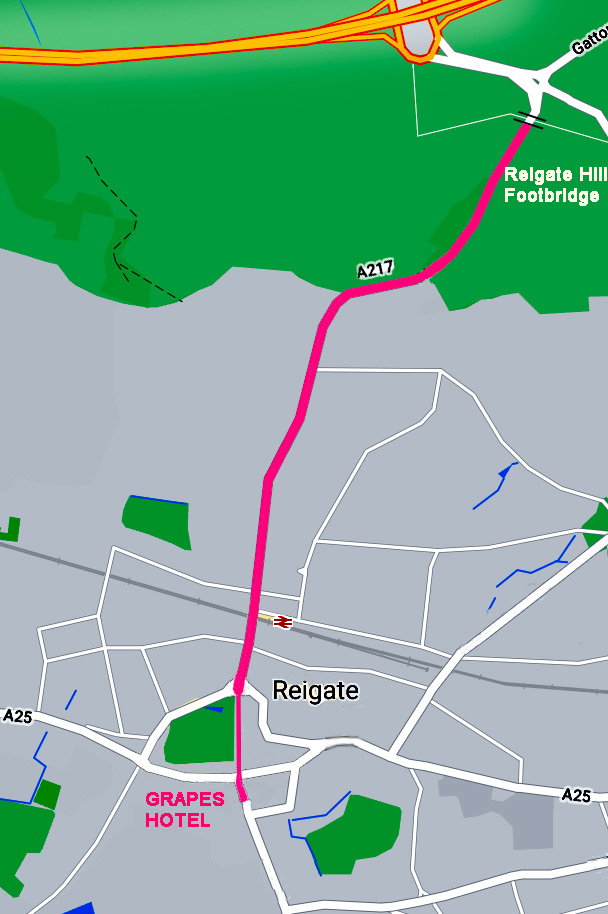
Current map showing same route, when the Tunnel was main A217
London road and before motorways had been though of. |
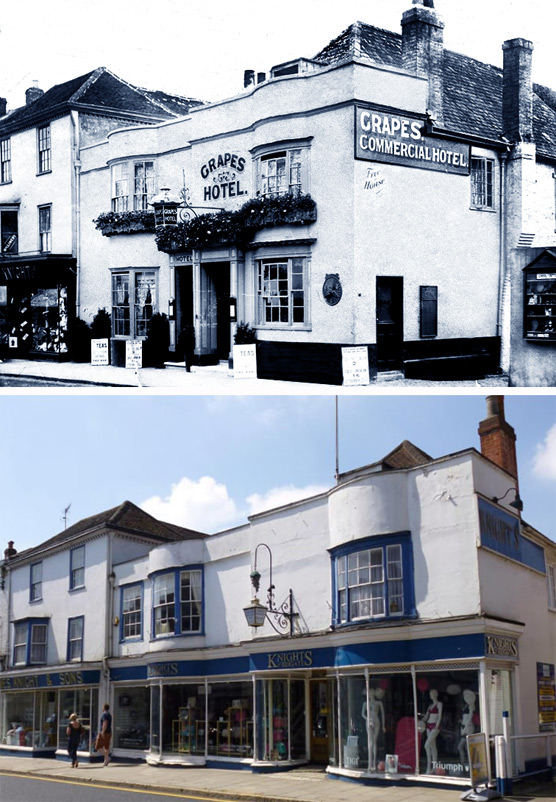
Grapes Hotel opened c1780 as Bunch of Grapes. Became bigger
Knights Store 1912-2016. Currently Oliver Bonas, dress shop.
|
.... and up through Reigate
Tunnel. The Tunnel was built
in 1823 by Earl Sommers, who lived on the hilltop in the town centre. His
estate stood between the town and the road north to London so he built a tunnel
below his grounds so the locals could get directly to the London road without
disturbing him. It is believed to be the first road tunnel in the world. It opened
in 1823, and a toll was levied for its use: ½d for a horse and 6d for a
coach and four. Pedestrians could use it free. It was freed of tolls in
1856.
 Please
Click on the thumbnail photos to see full size
pictures Please
Click on the thumbnail photos to see full size
pictures
|
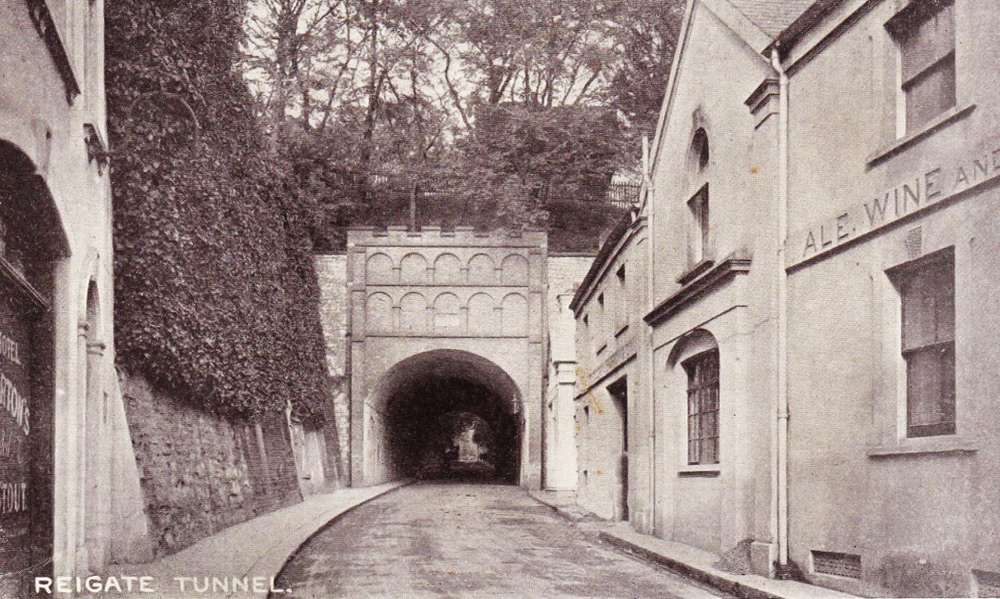 The Tunnel was eventually made one-way alternating north/south
controlled by traffic lights at each end of the tunnel. Absolute joy blasting through on a
motorbike !!
The Tunnel was eventually made one-way alternating north/south
controlled by traffic lights at each end of the tunnel. Absolute joy blasting through on a
motorbike !!
|

Under and around The Tunnel are Reigate Caves which produced fine sand and
which some people illegally dug in their basements until their house collapsed. |
.... Then over the railway line that
was opened in 1849, and up the hill, finishing at the 'suspension bridge' at the
top of Reigate Hill, as shown on the heading photo. The suspension bridge was an iron structure erected in 1825
when a deep cutting was formed through the chalk down in order to reduce the
gradient of the hill. It was replaced in 1910 by the present concrete bridge, as
below.
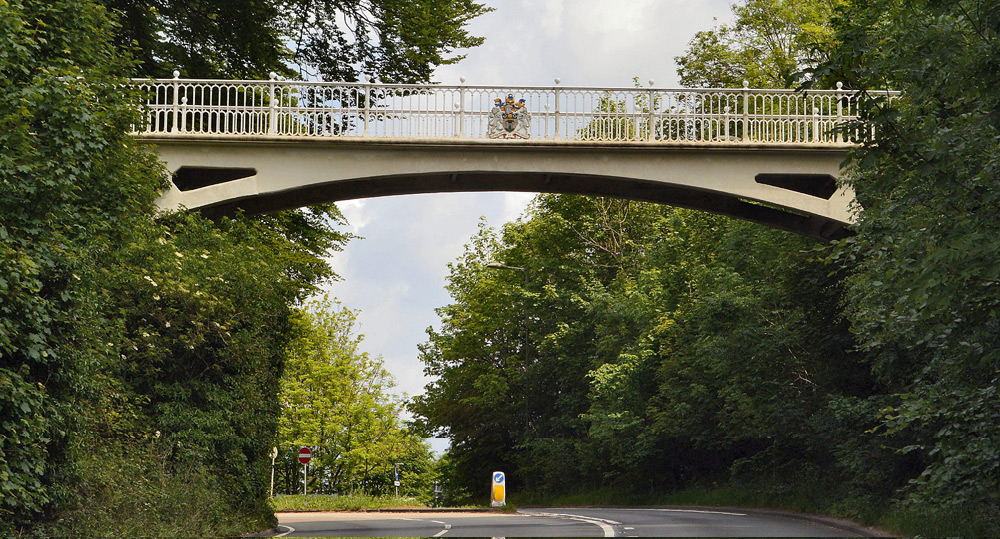
The following somewhat
lyrical, by today's standards, report of the event, which was inaugurated by
Surrey Bicycle Club, appeared in The Cyclist journal of September 8th 1880,
entitled: "Descriptive notes on the hill-climbing contest, Reigate
- (By 'one of the crowd')"
"It was not long, however before arrivals made
their appearance and 'ere one after another the 'great guns' arrived. The
'demon', wounded, with his left arm splintered and in a sling - for whose
predominate quality 'pluck' is inadequately expressive - despite his recent ill
luck, showed up like a Briton. We now ascend the - to most cyclists - unrideable
hill, taking up our station some 800 yards above the falling off point, viz,
where the narrow tracks of stone in the very loose and bad surface commence; a
leeward breeze blowing the while, favourably for the Hill-climbers.
The
commencement of action was announced by Coleman, of the Leytonstone BC, in
gold-laced jockey cap (O! vanity), heralded by a bustling referee on foot,
sailed along, well upright. F Chiesman (unattached) pluckily pulling the handles
of his machine, but labouring, preceded by a minute or so Cortis - wagging
laterally a bit, but putting the pace on despite riding one-handed. Percival, of
the Wanderers, followed, treading quick and sitting upright. Next came someone
progressing but slowly, but going very straight. Query, was this Oram (Capt.
West Kent)? Wigginton (Saturn BC), bearer of No.7, passed next, labouring;
whilst No.8, Goodbolt (of the Civil Service BC) went straight as a die, as if
feeling the importance, along that narrow track, of so doing, and though in a
milder manner, as if experiencing the Shakespearian sentiment - 'I have set my
life upon a cost, And I will stand the hazard of a die'.
Darling, Captain of the
Caledonian BC, a strong man with bare arms, pulling at his handles, bore No.6.
'Steady, Budd, steady!' was ejaculated as Budd, of the Surrey BC, though riding
in good form, yet being on a racer too light to well negotiate the nasty edging
of the flags, swerved somewhat perilously by. The riders left line of pavement
had hitherto been patronised by the competitors, but Whittaker, of the Croydon
BC on a good sized bicycle, preferred bowling by on the right hand side. 'All
right so far; No.19' sung out a portly party near us as Abraham, an Isle of
Wight BC man, navigated carefully along. Our stout friend then Bravoed! at the
good form of Crute, of the Sutton BC.
Twelve riders had now so far surmounted
the hill....The interval over, Hamilton, of the Druids BC, riding in upright
style, now spun by. Tacking rather from side to side, as if there was a screw
loose in his back wheel, did No.22 (Watkins, of the Surrey United BC), in a
puggaree, and, on a gleamingly-plated machine, sally by. No.23, grasping at
handles, passed, pumped along slowly, followed shortly by (?) a competitor
without a number, who came to grief just in front of us. Brown Blackwell (of the
Canonbury BC) next passed on the left track, riding straight and looking
sinister. No.25 (Gingell, of the Invicta BC), putting on a rattling pace, was
quietly followed after an interval by No.26, riding straight and under-grasping.
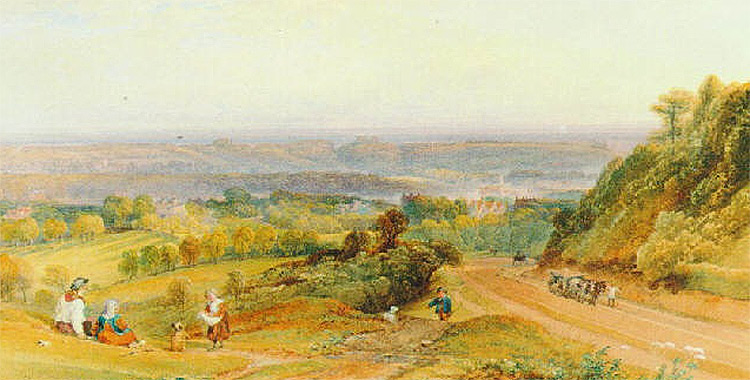
The first man we noticed adopting the hanging over style was No.28 (Hitchcock,
Crystal Palace BC), in white 'unwhisperables', and going straight; a few minutes
after whom No.30 an Isle of Wight man, in conspicuous brown uniform, formed a
good contrast as he cycled quickly by, sitting well erect. Cramphorn (where was
your No.ticket, Mr CWC?) with the big nob surmounting his cap, came next, riding
well; then on the right hand flags, 34, clad in grey, upright and going
straight; and No.36 on the left-hand side. Slow and unsteady, sticking his
'funny bones' out slightly, was No.37, who had chosen the left track, and was
pulling at his handles as he passed us ...Saunders (of the Clarence BC) worked
his machine along the left track with some body movement.
Soon after, 69 (an
unattached rider) bowled steadily by on the same track. Reynolds (of the London
BC) next excited some demonstrations of admiration as (on the left) he wound up
the acclivity seemingly faster than any of the previous strugglers. Followed by
several wheelmen propelling their steeds hind wheel foremost and cocked up in
the air. No.47 wobbled gallantly by on the right; then on the left, Cunningham,
of the Temple, passed pulling visibly with F C Neville (72) London BC on the
right track in his rear, whose good riding, an inebriate, who was quickly
collard, endeavoured to check. No.50 (on the right), passed well, as did 64
Morgan, a member of the Bristol BC - did you ride up expressly, Morgan? Bravo!
'I bet you a pound he don't go up!' cries a spectator, 'Who won't?' we lisp, and
turn our eyes at No.52 (Philpot, of Sevenoaks BC) on a plated machine, sitting
upright, squeezed along with difficulty.
Rucker (who had just previous to the
competition successfully scaled the hill) and Watson of the Surrey BC, riding
respectively on the right and left tracks, next passed close together going
well. Steering straight and sitting upright, McCaffrey, of the Brixton, next
went on the road to glory. Then came No.78, a Rover's man (G R Brown), with
conspicuous white gloves meandering along on the right hand track and looking
rather hard pressed...
Everybody seemed pleased with success of the hill
climbing competition, but of course there is 'no rose without a thorn', and the
enjoyment of two individuals was marred through the backbones of their well
plated machines snapping in an extraordinary manner.... Particulars of hill
Length from Grapes Hotel to Suspension Bridge, 2640 yards (1½ miles). Rise, 420
feet. Average gradient, 4½ feet in 100 feet. Average gradient on tramway, 10
feet in 100 feet. Severest gradient on tramway, 12 feet in 100 feet."
The 'tramway' mentioned had nothing to do with trams. Reigate
Hill was a narrow road constructed like most at that time with graded stones
rolled flat, probably with a liberal coating of mud or chalk washed out from the
side banks together with horse dung, etc. Early photographs show the tramway,
which consisted of two continuous parallel stretches of flagstones approximately
eighteen inches wide on the steepest part of the hill, set in the road surface
at a suitable distance apart to suit the track of a horse drawn cart or
carriage, the purpose being to reduce the rolling resistance of the wheels of
the vehicle. Note the reference to " the very loose and bad surface"
where the tracks of stone commenced. The aim of the 'Wheelman' therefore would
be to try to keep his machine on one of these tracks in order to make the best
time.
At least 74 riders entered the event from as far afield as Derby and
Bristol, of which 29 did not start and around 27 failed to complete the course,
three recorded as having fallen. The winner was Charles Crute, Captain of the
Sutton Bicycle Club, in a time of 8½ minutes. In the 'Remarks' column on the
results sheet his performance was described as "Fast and in excellent
form".
 Please
Click on the thumbnail photos to see full size
pictures Please
Click on the thumbnail photos to see full size
pictures
 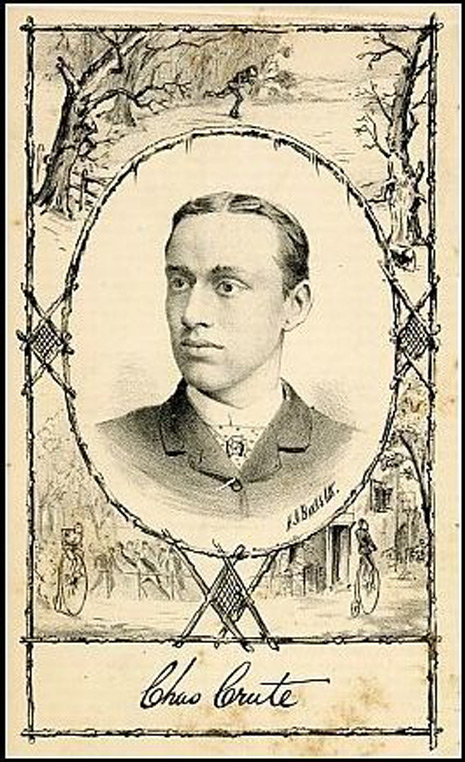
Winner of the 1880 Reigate Hill
Climb
Charles Crute, Captain, Sutton Bicycle Club |
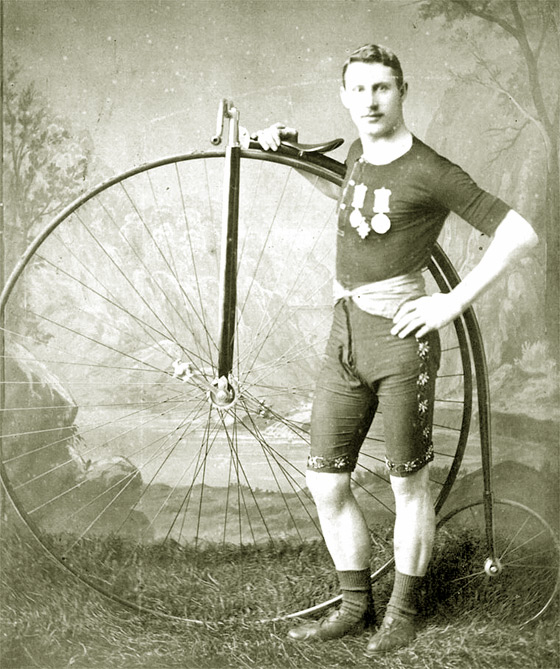
Equal second was H.L.Cortis, with broken
arm.
 The Wanderers Bicycle Club
The Wanderers Bicycle Club |
Equal second was H.L.Cortis of the Wanderers club (the chap with the
broken arm!) in a time of 9 minutes - "In his usual style, but with one arm
in a splint". The same time was accorded to J R Hamilton of the Druids Club
- "Splendidly ridden". Three riders recorded the third best time of 10
minutes, G J Hunter of the Isle of Wight - "Very well ridden", F W
Payne of C.B.J.C - "Ridden in good form" and T G Neville of the London
Club - "Moderately easy, in good form". The slowest time was 15
minutes recorded by H.R.Reynolds of the Dark Blue and London Club who rode
"Very steadily and well". Bronze medals were awarded to all those who
completed the climb.
So, what's it like to ride a Veteran bicycle up "the
unrideable" Reigate Hill? There's only one way to find out - dust off the
trusty old bike and have a go!
Results to be advised next
month, after a bit of a rest,
.... Chas Moody


Classics
at Penshurst
- October 2020 We
have received a lovely photo from Andrew Randall to prove there is still some
life outside Covid and that at least some of our Members are taking their
machines out for a communal drive in the country. The location is Penshurst
Place in Kent, a 14th century Manor House and Gardens.
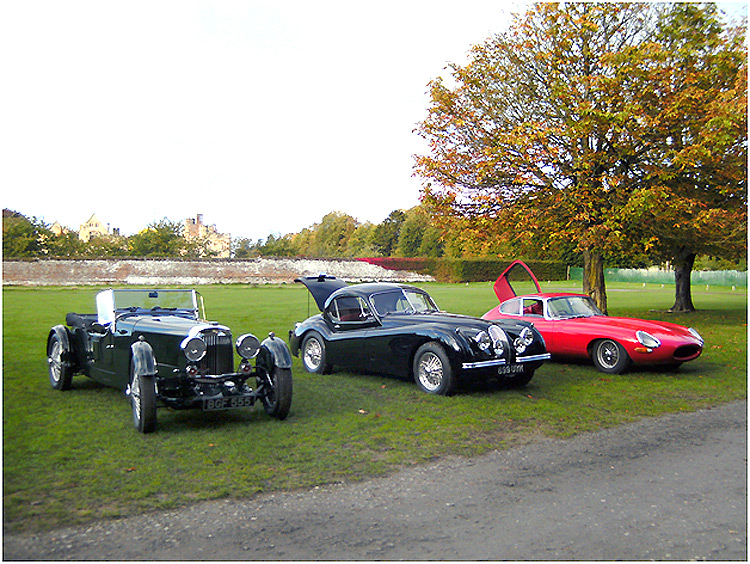
 1934 Aston Martin Mk
II
- 1952 Jaguar XK
120
- 1968 Jaguar E-type 1934 Aston Martin Mk
II
- 1952 Jaguar XK
120
- 1968 Jaguar E-type
This is a venue that the SVVS has visited a few times; very attractive and with
a very chequered history. The present manor house was built in 1341 for a London
merchant and four times Lord Mayor of London who wanted a country residence
within easy distance of London. This was at the time when such properties ceased
to be castles: they were more dwellings that could be defended in an emergency.
A subsequent owner Edward Stafford, 3rd Duke of Buckingham was executed in 1521
by King Henry VIII following a lavish feast held at Penshurst Place hosted by
the Duke in honour of Henry. Henry then used Penshurst Place as a hunting lodge,
being only a few miles from Hever Castle, childhood home of Anne Boleyn. In
1550, Henry VIII's son, King Edward VI, granted the house and estate to Sir
Ralph Fane but it was forfeited two years later after Sir Ralph was executed for
treason.

King Edward
VI subsequently granted the estate to Sir William Sidney in 1552. The Sidney family have been in
continuous occupation for more than 460 years.
Go to Recent Venues
Page
PICTURE GALLERY INDEX
|

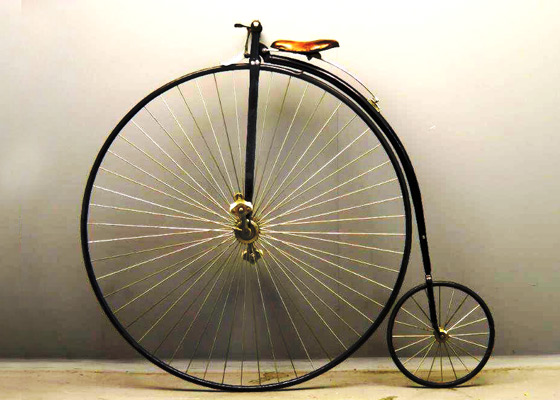



 The Tunnel was eventually made one-way alternating north/south
controlled by traffic lights at each end of the tunnel. Absolute joy blasting through on a
motorbike !!
The Tunnel was eventually made one-way alternating north/south
controlled by traffic lights at each end of the tunnel. Absolute joy blasting through on a
motorbike !!






